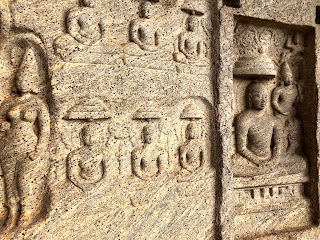Situated in the heart of Thirunelveli town on the north bank of the Thamirabarani river, is the vast and majestic Nellaiappar temple. At 14.5 acres this twin temple complex is slightly larger in area than the Meenakshi - Sundareswarar in Madurai. It lacks the tall gopurams of Madurai but has many of the same features like the massive sculptures that you see there. It also has the famed musical columns. It is a Paadal Petra Sthalam and has been praised in song by all three of the Moovar, Gnanasampanthar, Appar and Suntharar. It has been in existence since the 7th century at least and the two temples were joined together by the impressive Sankili Mandapam in 1647 and the entire complex is enclosed by a wall. Although the Saivite Pandian king Arikesari Nindraseer Nedumaran is credited with the initial construction in the 7th century, many dynasties including Chola and later Pandian kings contributed to it. Much of the architecture that we see today is from the Nayakkan era.
Legend says that a poor farmer prayed to Sivan to protect his ready-to-harvest rice paddy from an impending storm and Sivan himself came to his aid and built a fence. That is why it is called Thirunelveli. The Lord here is also called Venunathar because they say this used to be a bamboo forest.
It is one the five Pancha Sabas (பஞ்ச சபைகள்) of Lord Nataraja. The Ponnambalam (பொன்னம்பலம்) or Golden Hall is in Chidambaram. The Velliambalam (வெள்ளியம்பலம்) or Hall of Silver is in Madurai. The Rathina Sabai (இரத்தின சபை) or the Hall of Rubies is in Thiruvalankadu where he performed the Rudrathaandavam. The Chitra Sabai (சித்திர சபை) or Hall of Paintings is in Kutralam and the Thaamira Sabai (தாமிர சபை) or Hall of Copper is here in Tirunelveli. The Thaamira Sabai is found in one of the inner precincts.
We went on a Friday evening and the temple was busy but in a pleasant way. Groups of people were moving along the precincts singing the Thevarams of our childhood and clapping on their cymbals. In the outer precincts old men and women were telling stories from the Puranas to eager young kids who were enthralled. This is a scene that has played out in these halls for a thousand years or more without a break. We were so wrapt in the atmosphere that I forgot to take a lot of pictures.

























































